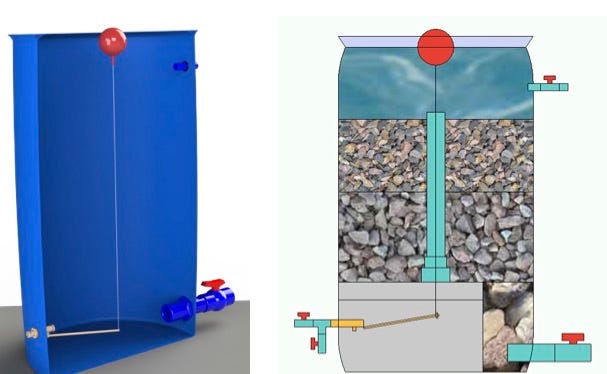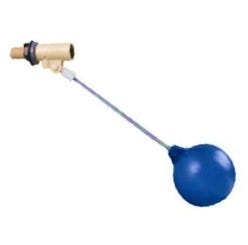Updated biochar water treatment graphical manuals
and a DIY guide to gravel roughing filtration
Inlet control system for “blue barrel” gravel roughing filter made by adapting the widely available balloon-and-arm type float valve
In this post:
links to download (free) updated graphical manuals for biochar water treatment systems with new design options for gravel filter inlet control using different configurations and types of float valves
link to (paid subscriber) book section on gravel roughing filtration - includes concepts and engineering principles for designing roughing filters for removal of turbidity (suspended sediment and particulates) in a variety of water treatment applications
In March and April of 2012 I was working with a group of Karen people on the border of Thailand and Burma to conduct a natural building workshop. Our project was to build a schoolhouse from adobe bricks made by mixing local mud with rice husks with our feet, pouring the mix into wooden forms, and letting the bricks dry in the sun for serval days.
During long days of brick making we got to talking about designing a semi-portable water treatment system along the lines of the (non-portable) system we had built at Pun Pun a few years earlier. Many of the local Karen were familiar with the Pun Pun system, made from prefabricated concrete rings stacked and sealed with cement, the technique commonly used to construct water tanks on Thai farms.
They liked the concept but told me there was no way to get such bulky, heavy materials as concrete rings to many of their remote villages in the rugged jungle. Was there a way to make a smaller system made from materials that could be transported in the back of a pickup, or carried in on-foot?
My buddy Rocky pointed to the blue plastic drum next to the mud pit that we had filled with water for mixing adobe - “What about using drums like this?” he asked. “We can get them easily.”
I thought that was a brilliant idea. We set about shrinking down the Pun Pun system to get everything to fit into the ubiquitous 200 L (55-gal) HDPE plastic drums. The drums and associated PVC fittings could be carried long distances over rugged terrain by stout Karen porters. Once on site, gravel and sand fractions could be obtained from a nearby stream or riverbed, sieved with common household materials such as poultry netting, and the biochar generated from chopped local surplus biomass. The “blue barrel” treatment system was born!
Transporting blue drums to water treatment workshop location in Karen state by river.
Like many of the ethnic “hill tribe” people of Burma Karen people are often on the move, since they have been in various stages of conflict from tenuous ceasefires to open hot war with the Burma army for decades. Villagers often have to flee their homes into the jungle on short notice. In theory, at least, if a village has sufficient notice before a coming offensive they could dump the filter media out of the drums, disconnect the fittings, haul the drums to a safe location, and set the whole system up again with newly acquired filter media. Voila! Drinking water for a whole village in exile. Piece of cake, right? Not so much. But not completely impossible, either.
The trickiest bit of design in the blue barrel treatment system is the water inlet control mechanism. For reasons elaborated in the “Gravel roughing filtration” section of the book, the gravel filter should be operated in up-flow mode for best performance. In other words, water needs to enter the gravel filter at the bottom of the drum, and flow upwards through the media.
The challenge was how to introduce water at the bottom of the gravel drum while controlling the level of water throughout the whole treatment system. In other words, to take advantage of gravity flow for moving water through the treatment system while keeping the drums from overflowing, and having the system automatically shut off when water was not in use. And do this with locally available and inexpensive hardware.
The humble balloon-and-arm float valve is a ubiquitous, simple device for maintaining water levels in tanks of all sorts.
balloon-and-arm float valve
It took a little MacGyvering but we rigged up a system for using balloon-and-arm float valve as an inlet control for an up flow gravel filter that could also set an appropriate water level throughout the treatment system.
We installed the valve in the bottom of the gravel filter drum, and attached the balloon to the arm by a string, so that the ballon could bob at the top of the drum and keep it filled with water, as shown in the image at the top of this post.
The tricky bit is constructing a vault in the underdrain of the gravel filter, so that the oat valve arm had plenty of room to swing without impediment to turn slow on and off as needed. And to protect the string attached to the floater, to keep it from getting hung up.
Float valve arm protected in a vault made from bricks and stones in the bottom of gravel filter
vault covered with section of barrel top, string protection channel PVC pipe
The assembly made from large rocks, bricks, or concrete blocks and a PVC pipe channel did the trick. However, this approach has some disadvantages.
If the vault collapses, or gravel or other objects enter the vault, this can cause the valve arm to jam. The string attaching the floater can catch, impairing valve operation. And if anything goes wrong, you pretty much have to take everything out of the filter and start over. It’s not possible to easily access the valve for maintenance or troubleshooting.
Over the years we’ve come to consider the float valve arrangement to be the weak point of the system. It’s the only moving part, it’s somewhat vulnerable to disturbance and failure, and it’s not easy to get to.
Recently we’ve come up with some new design options that solve these challenges. While not as universally available as the trusty balloon-and-arm model, float valves made for livestock water tanks are more physically robust - typically housing the floater inside some kind of protective metal or plastic housing. Some models of stock tanks valves bolt firmly onto tank edges (such as the “Trough-O-Matic”), while others such as the Hudson valve fit nicely inside of protective PVC pipes.
We figured out some ways to affix these valves at the top of the gravel filter - for easy access - and channel their outflow to the bottom of the drum to maintain optimal filter operation in upflow mode. Our updated graphical manuals include these additional design options for inlet and water level control on the gravel roughing filter. They are available to download for free from Aqueous Solutions:
300 Liter per day “blue barrel” treatment system graphical manual, 2022 edition
2000 Liter per day “PunPun” treatment system graphical manual, 2022 edition
And if you’re ready for a deeper dive into the fascinating (no kidding!) topic of Do-It-Yourself roughing filtration, please consider scribing to this substack to receive full access to the book section to “Gravel roughing filtration” as well as all the other content related to low-cost decentralized water treatment.
BONUS: In my opinion, the best one-stop resource on rouging filtration is Martin Wegelin’s 1996 “Surface Water Treatment by Roughing Filters: A Design, Construction and Operation Manual.” It’s available for download from IRC.









Hello Josh. Thank you for your amazing work.
I have a question about the meshes that are shown on the video. Since the meshes are not in the list of materials, are they necessary or not?
In case they are, do we need to buy something that is alimentary grade?
Thanks
The filter system is currently working off grid in Upstate NY. I resolved the issue of not being present for weeks at a time and the water getting stagnant with no flow by using a rain barrel timer which releases water once a day to keep waterflow moving throughout the system. I do have a question regarding biochar. Do you recommend acid washing or "treating" the biochar prior to using? or is it fine to just crush it up and use it right after creating it?